Stator Core Shape Design for Low Core Loss and High Power Density of a Small Surface-Mounted Permanent Motor
Abstract
1. Introduction
2. Analysis Condition and Analysis Technique
- Change the number of winding turns to keep the effective value of the back EMF constant whether the stator shape is changed.
- Calculate the coil resistance using the turn’s number ratio because the diameter of the winding wire is constant.
- Analyze various motors with different stator core shapes by inputting the same three-phase sinusoidal wave voltage.
3. Stator Core Shape Design Method
3.1. Shape Design for Core Loss Reduction
3.2. Shape Design for Improving Power Density
4. Conclusions
Author Contributions
Funding
Conflicts of Interest
References
- Sulaiman, E.; Kosaka, T.; Matsui, N. High Power Density Design of 6-Slot-8-Pole Hybrid Excitation Flux Switching Machine for Hybrid Electric Vehicles. IEEE Trans. Magn. 2011, 47, 4453–4456. [Google Scholar] [CrossRef]
- Sulaiman, E.; Ahmad, M.Z.; Kosaka, T.; Matsui, N. Design Optimization Studies on High Torque and High Power Density Hybrid Excitation Flux Switching Motor for HEV. Procedia Eng. 2013, 53, 312–322. [Google Scholar] [CrossRef]
- Ooi, S.; Morimoto, S.; Sanada, M.; Inoue, Y. Performance Evaluation of a High-Power-Density PMASynRM With Ferrite Magnets. IEEE Trans. Ind. Appl. 2013, 49, 1308–1315. [Google Scholar] [CrossRef]
- Fan, T.; Li, Q.; Wen, X. Development of a High Power Density Motor Made of Amorphous Alloy Cores. IEEE Trans. Ind. Electron. 2014, 61, 4510–4518. [Google Scholar] [CrossRef]
- EL-Refaie, A.M.; Alexander, J.P.; Galioto, S.; Reddy, P.B.; Huh, K.K.; de Bock, P.; Shen, X. Advanced High-Power Density Interior Permanent Magnet Motor for Traction Applications. IEEE Trans. Ind. Appl. 2014, 50, 3235–3248. [Google Scholar] [CrossRef]
- Soda, N.; Enokizono, M. Stator Shape Design Method for Improving Power Density in PM Motor. IEEE Trans. Magn. 2017, 53, 9100504. [Google Scholar] [CrossRef]
- Enomoto, Y.; Ito, M.; Koharagi, H.; Masaki, R.; Ohiwa, S.; Ishihara, C.; Mita, M. Evaluation of Experimental Permanent-Magnet Brushiless Motor Utilizing New Magnetic Material for Stator Core Teeth. IEEE Trans. Magn. 2005, 41, 4304–4308. [Google Scholar] [CrossRef]
- Denis, N.; Kato, Y.; Ieki, M.; Fujisaki, K. Core Losses of an Inverter-fed Permanent Magnet Synchronous Motor with an Amorphous Stator Core under No-load. Aip Adv. 2016, 6, 055916. [Google Scholar] [CrossRef]
- Okamoto, S.; Denis, N.; Kato, Y.; Ieki, M.; Fujisaki, K. Core Loss Reduction of an Interior Permanent-Magnet Synchronous Motor Using Amorphous Stator Core. IEEE Trans. Ind. Appl. 2016, 52, 2261–2268. [Google Scholar] [CrossRef]
- Denis, N.; Inoue, M.; Fujisaki, K.; Itabashi, H.; Yano, T. Iron Loss Reduction in Permanent Magnet Synchronous Motor by Using Stator Core Made of Nanocrystalline Magnetic Material. IEEE Trans. Magn. 2017, 53, 8110006. [Google Scholar] [CrossRef]
- Miyama, Y.; Hazeyama, M.; Hanioka, S.; Watanabe, N.; Daikoku, A.; Inoue, M. PWM Carrier Harmonic Iron Loss Redution Technique of Permanent-Magnet Motors for Electric Vehicles. IEEE Trans. Ind. Appl. 2016, 52, 2865–2871. [Google Scholar] [CrossRef]
- Yamazaki, K.; Togashi, Y.; Ikemi, T.; Ohki, S.; Mizokami, R. Reduction of Inverter Carrier Harmonic Losses in Interior Permanent Magnet Synchronous Motors by Optimizing Rotor and Stator Shapes. IEEE Trans. Ind. Appl. 2019, 55, 306–315. [Google Scholar] [CrossRef]
- Enokizono, M.; Wakabayashi, D.; Tsuchida, Y.; Ueno, S.; Soda, N. Core Loss Reduction for High-Speed Motor. In Proceedings of the 2018 XIII International Conference on Electrical Machines (ICEM), Alexandroupoli, Greece, 3–6 September 2018; pp. 2586–2592. [Google Scholar] [CrossRef]
- Saitz, J. Computation of the Core Loss in an Induction Motor Using the Vector Preisach Hysteresis Model Incorporated in Finite Element Analysis. IEEE Trans. Magn. 2000, 36, 769–773. [Google Scholar] [CrossRef]
- Nam, H.; Ha, K.H.; Lee, J.J.; Hong, J.P.; Kang, G.H. A Study on Iron Loss Analysis Method Considering the Harmonics of the Flux Density Waveform Using Iron Loss Curves Tested on Epstein Samples. IEEE Trans. Magn. 2003, 39, 1472–1475. [Google Scholar] [CrossRef]
- Ma, L.; Sanada, M.; Morimoto, S.; Takeda, Y. Prediction of Iron Loss in Rotating Machines with Rotational Loss Included. IEEE Trans. Magn. 2003, 39, 2036–2041. [Google Scholar] [CrossRef]
- Yu, Q.; Bilgin, B.; Emadi, A. Loss and Efficiency Analysis of Switched Reluctance Machines Using a New Calculation Method. IEEE Trans. Ind. Electron. 2015, 62, 3072–3080. [Google Scholar] [CrossRef]
- Kim, J.; Jeong, I.; Nam, K.; Yang, J.; Hwang, T. Sensorless Control of PMSM in a High-Speed Region Considering Iron Loss. IEEE Trans. Ind. Electron. 2015, 62, 6151–6159. [Google Scholar] [CrossRef]
- Takeda, Y.; Takahashi, Y.; Fujiwara, K.; Ahagon, A.; Matsuo, T. Iron Loss Estimation Method for Rotating Machines Taking Account of Hysteretic Property. IEEE Trans. Magn. 2015, 51, 7300504. [Google Scholar] [CrossRef]
- Soda, N.; Enokizono, M. Relation between Stator Core Shape and Torque Ripple for SPM Motor. In Proceedings of the 2018 XIII International Conference on Electrical Machines (ICEM), Alexandroupoli, Greece, 3–6 September 2018; pp. 955–960. [Google Scholar] [CrossRef]
- Urata, S.; Enokizono, M.; Todaka, T.; Shimoji, H. The Calculation Considered Two-Dimensional Vector Magnetic Properties Depending on Frequency of Transformers. IEEE Trans. Magn. 2006, 42, 687–690. [Google Scholar] [CrossRef]
- Enokizono, M. Vector Magneto-Hysteresis E&S Model and Magnetic Characteristic Analysis. IEEE Trans. Magn. 2006, 42, 915–918. [Google Scholar] [CrossRef]
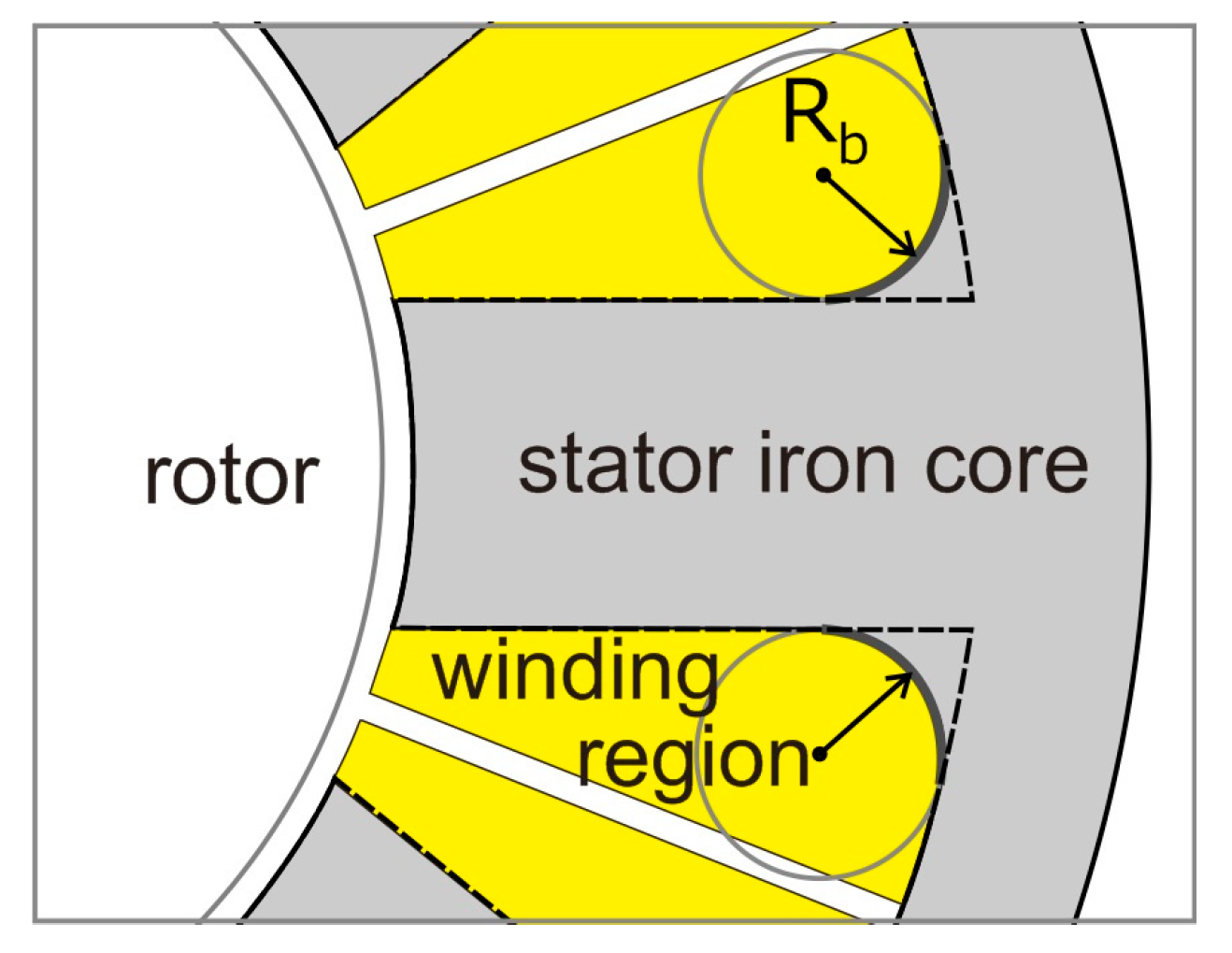
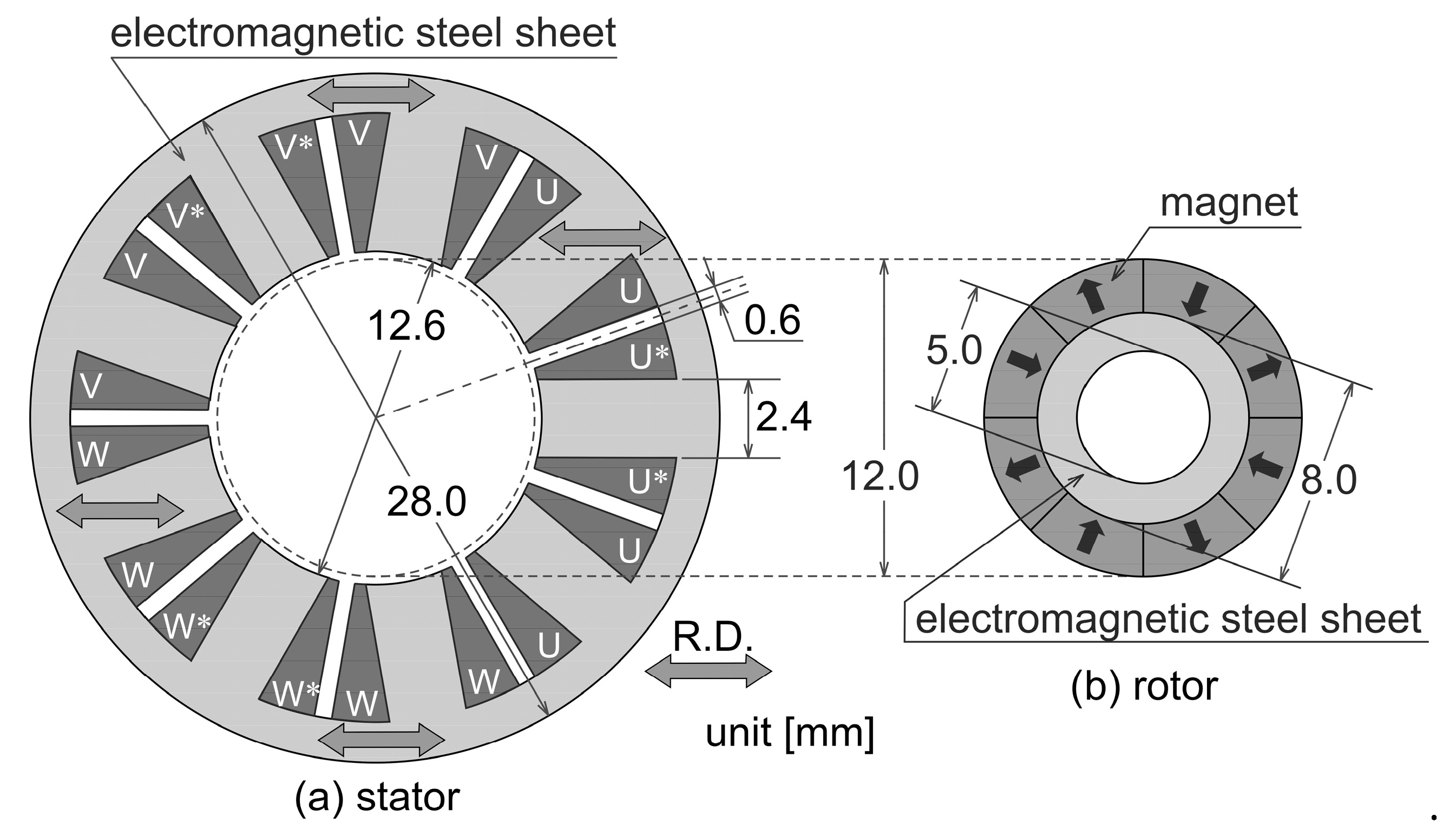

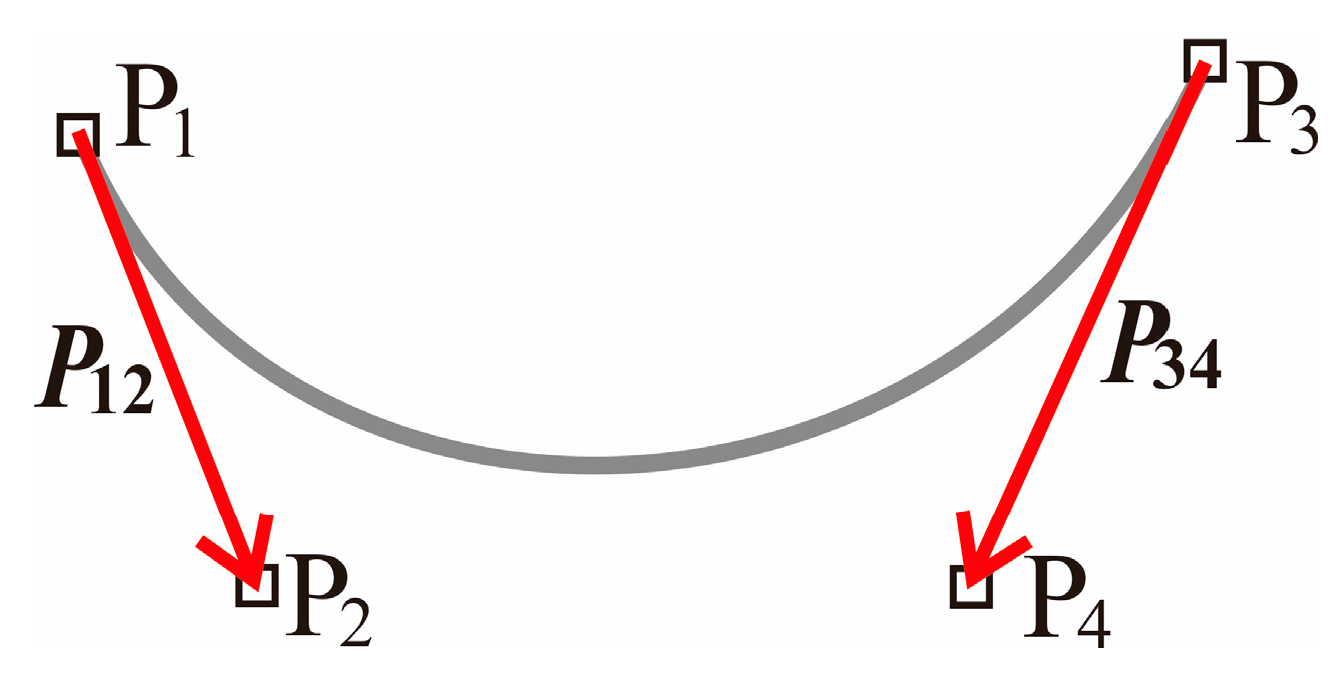
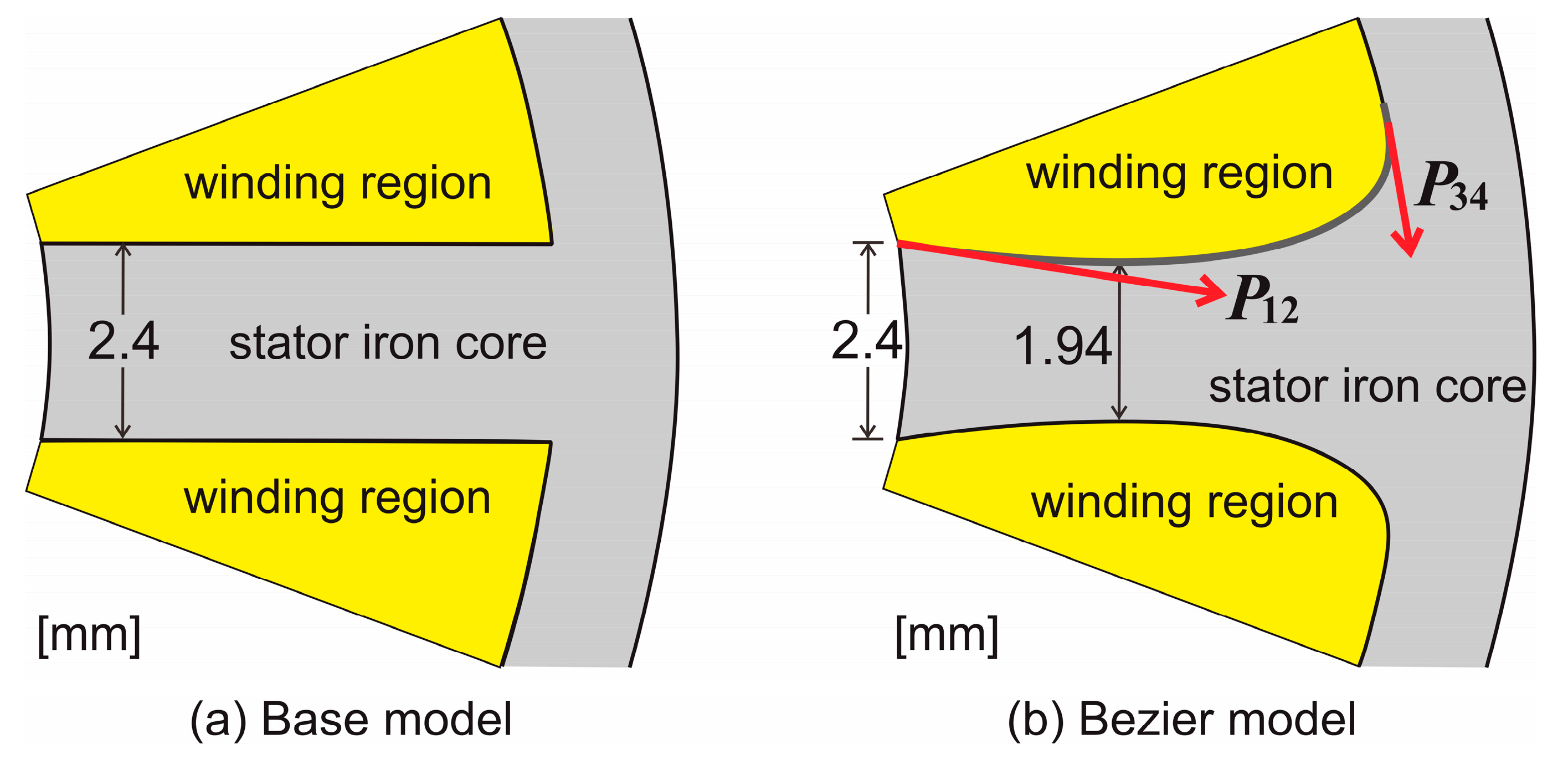
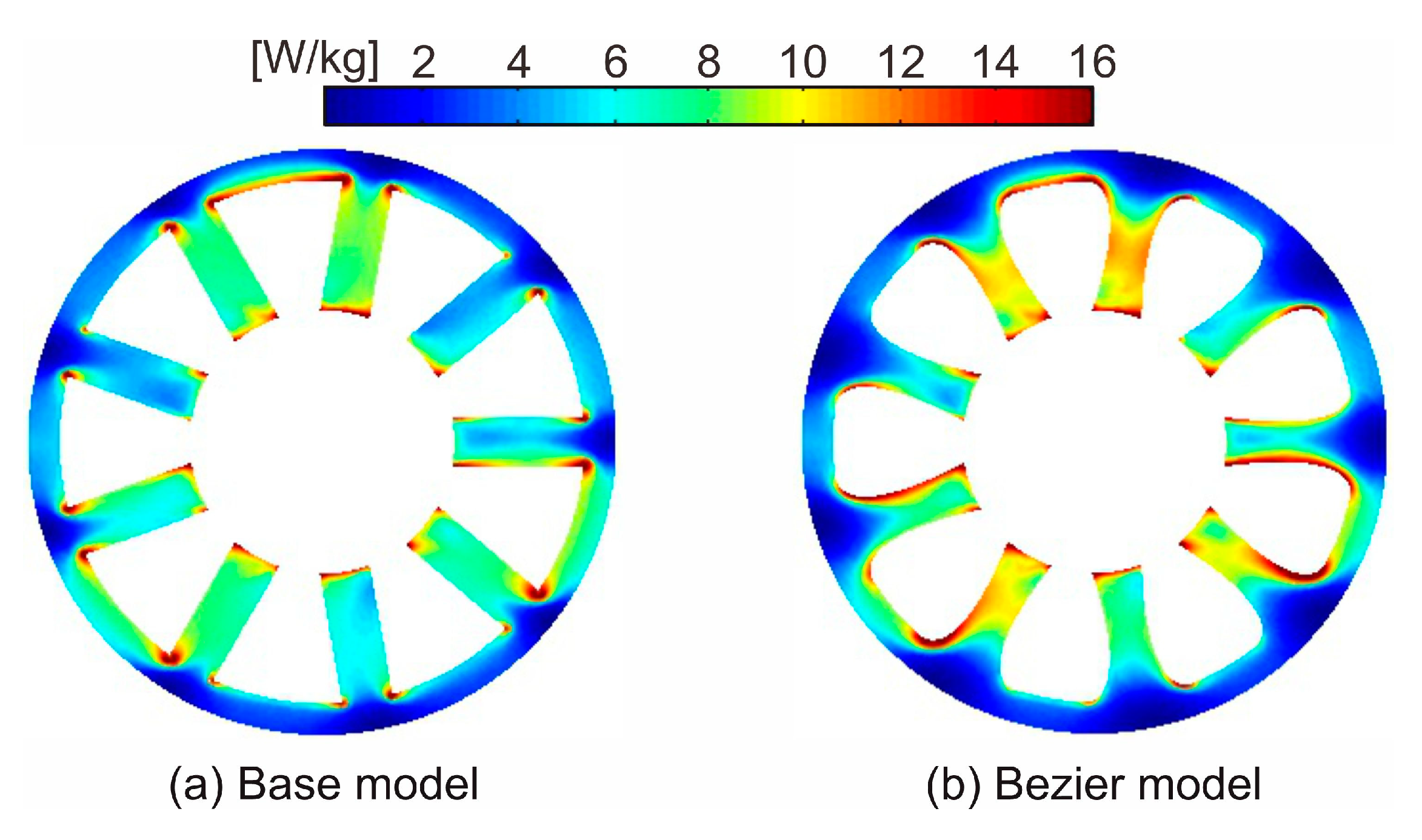
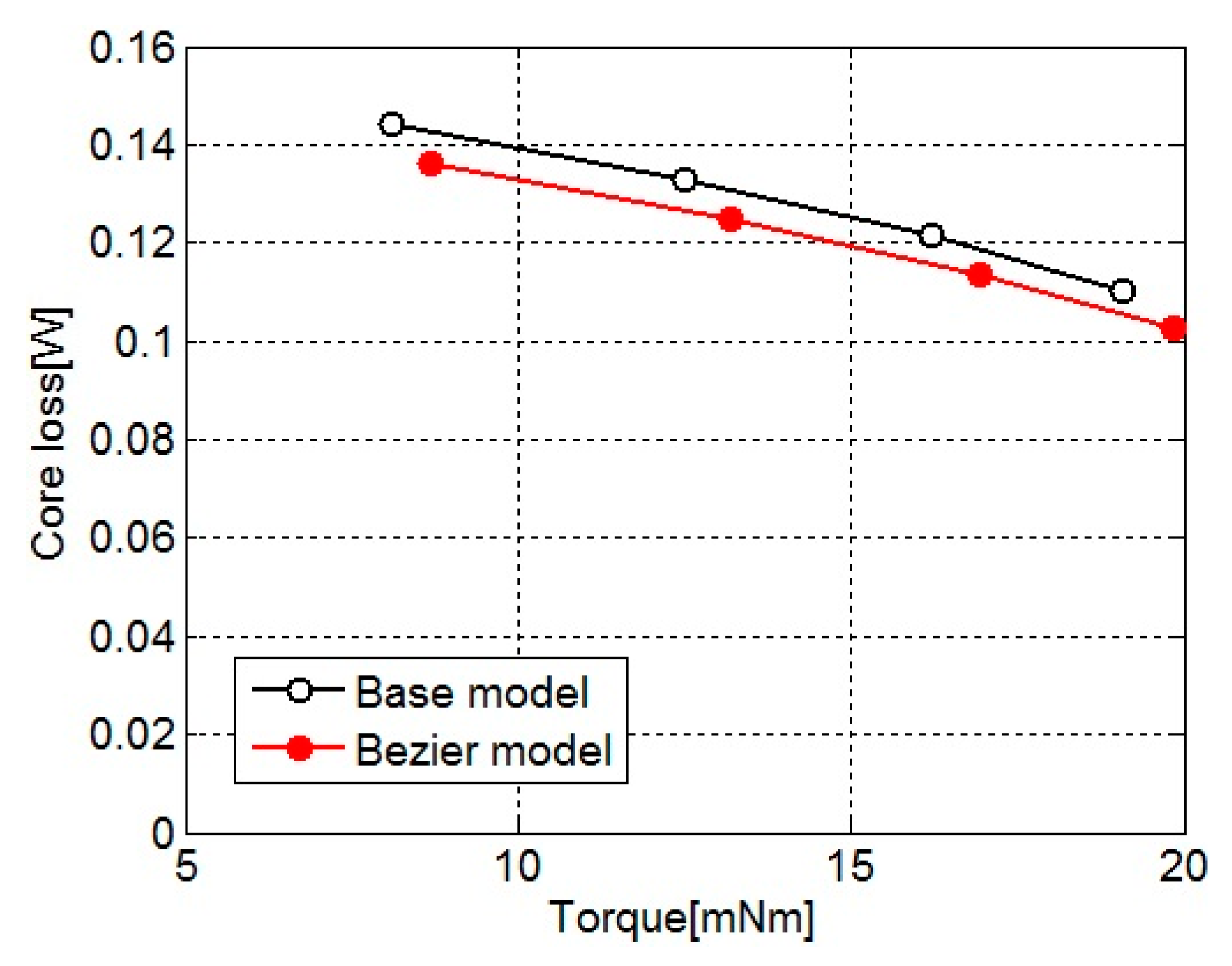
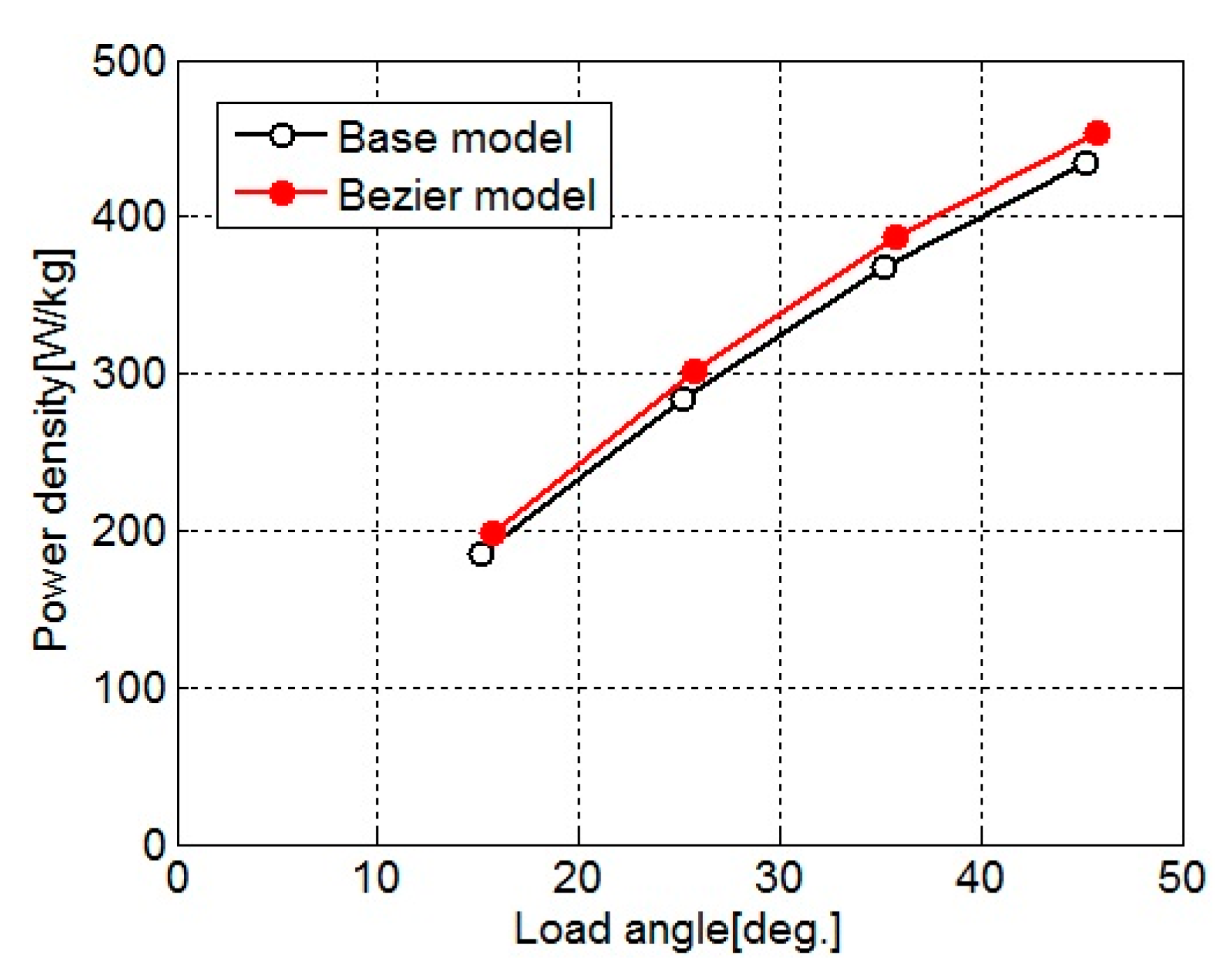

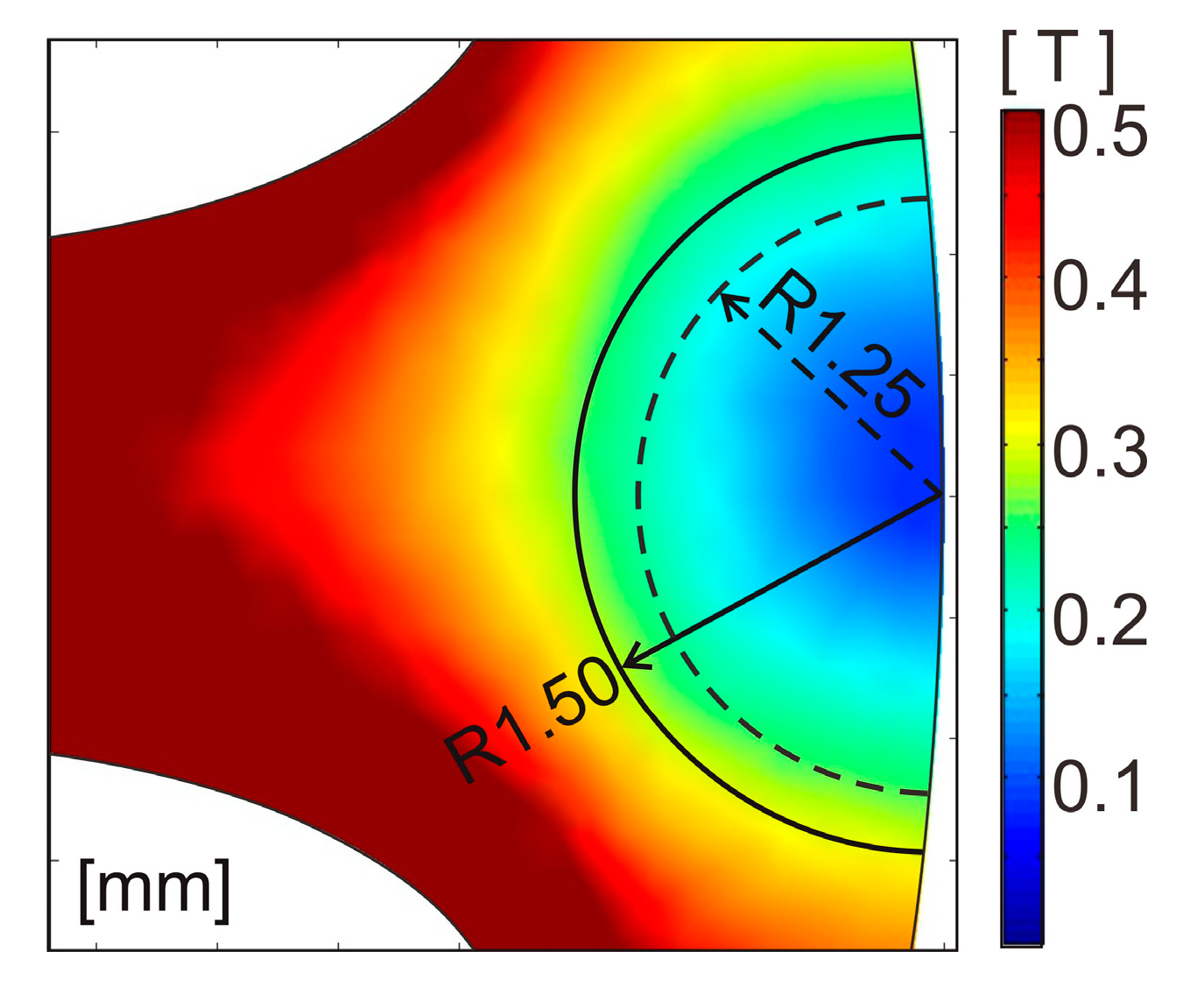



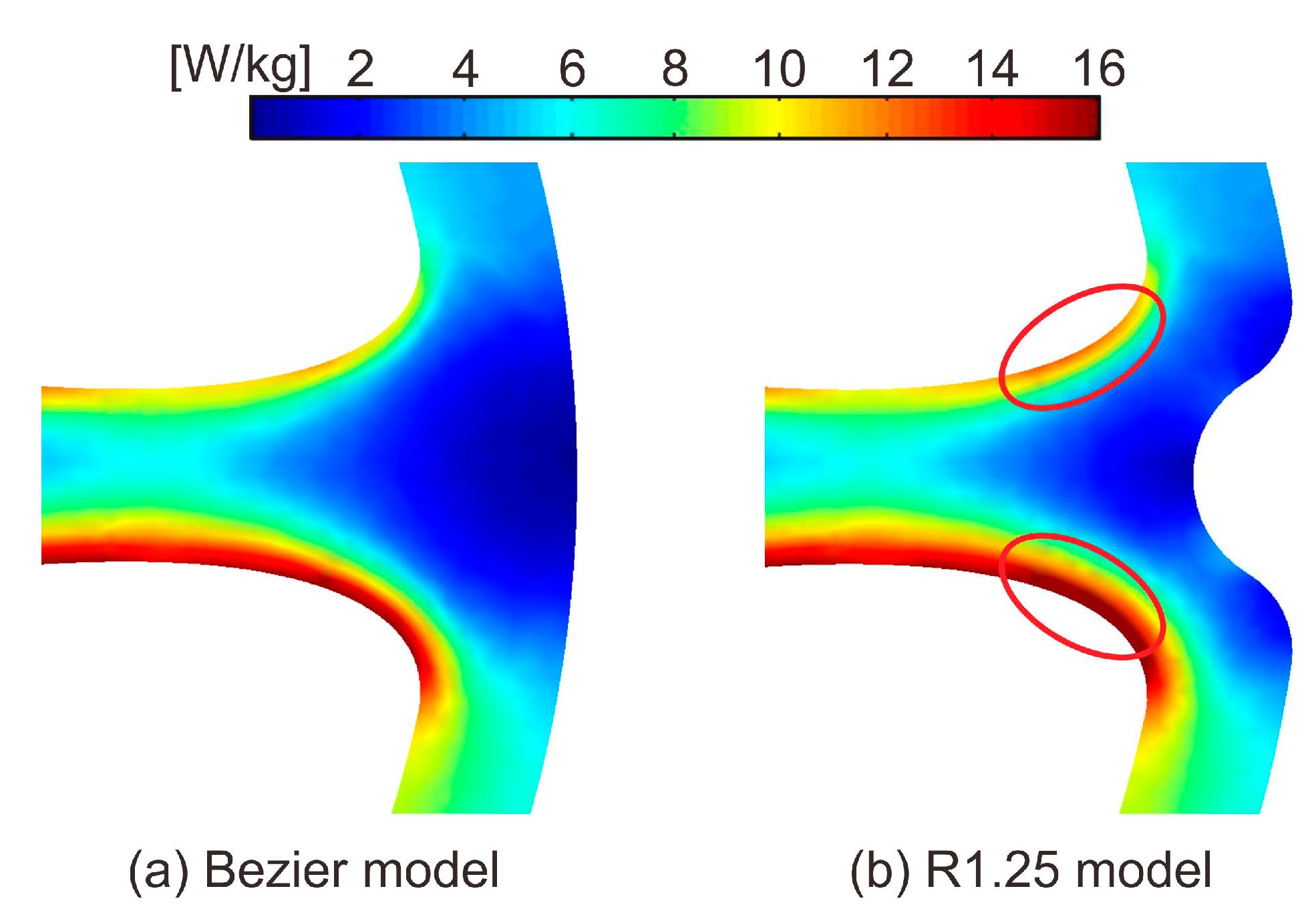


| Model | Number of Turns in Phase Winding | Coil Resistance [Ω] | Winding Fill Factor [%] |
|---|---|---|---|
| Base model | 44.71 | 0.9853 | 46.02 |
| Bezier model | 44.87 | 0.9888 | 45.54 |
| Model | Coil’s Weight [g] | Stator Core’s Weight [g] | Motor’s Weight [g] |
|---|---|---|---|
| Base model | 10.15 | 24.95 | 46.10 |
| Bezier model | 10.19 | 24.68 | 45.87 |
| Model | Coil Weight [g] | Stator Core Weight [g] | Motor Weight [g] |
|---|---|---|---|
| R1.25 model | 10.19 | 22.41 | 43.60 |
| R1.50 model | 10.19 | 21.48 | 42.67 |
© 2020 by the authors. Licensee MDPI, Basel, Switzerland. This article is an open access article distributed under the terms and conditions of the Creative Commons Attribution (CC BY) license (http://creativecommons.org/licenses/by/4.0/).
Share and Cite
Soda, N.; Enokizono, M. Stator Core Shape Design for Low Core Loss and High Power Density of a Small Surface-Mounted Permanent Motor. Sensors 2020, 20, 1418. https://doi.org/10.3390/s20051418
Soda N, Enokizono M. Stator Core Shape Design for Low Core Loss and High Power Density of a Small Surface-Mounted Permanent Motor. Sensors. 2020; 20(5):1418. https://doi.org/10.3390/s20051418
Chicago/Turabian StyleSoda, Naoya, and Masato Enokizono. 2020. "Stator Core Shape Design for Low Core Loss and High Power Density of a Small Surface-Mounted Permanent Motor" Sensors 20, no. 5: 1418. https://doi.org/10.3390/s20051418
APA StyleSoda, N., & Enokizono, M. (2020). Stator Core Shape Design for Low Core Loss and High Power Density of a Small Surface-Mounted Permanent Motor. Sensors, 20(5), 1418. https://doi.org/10.3390/s20051418





